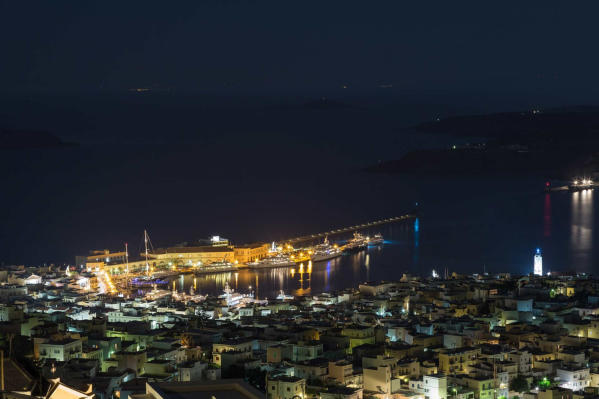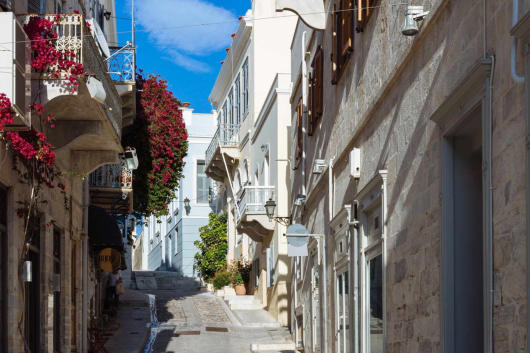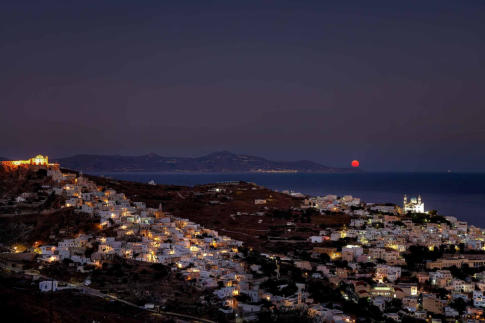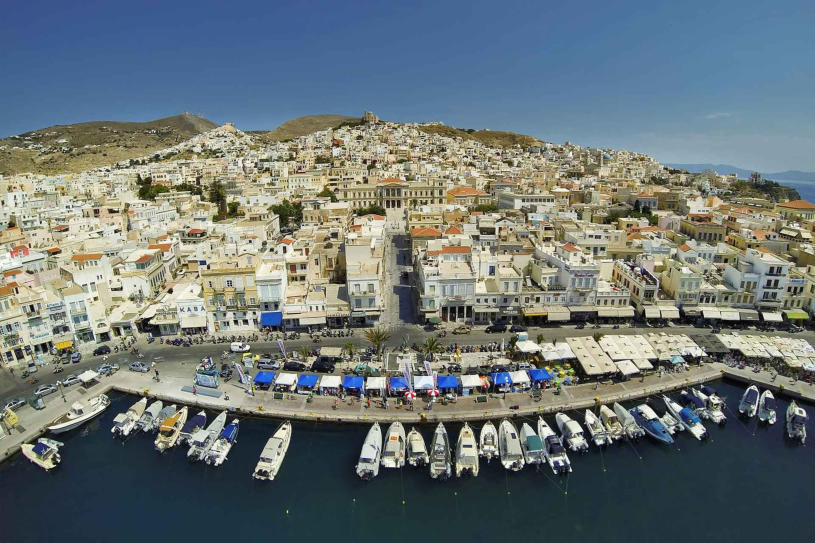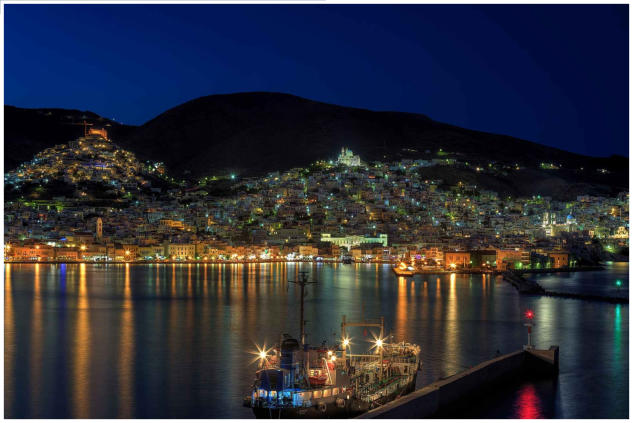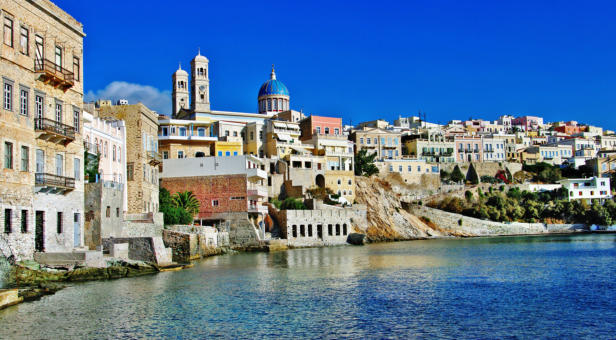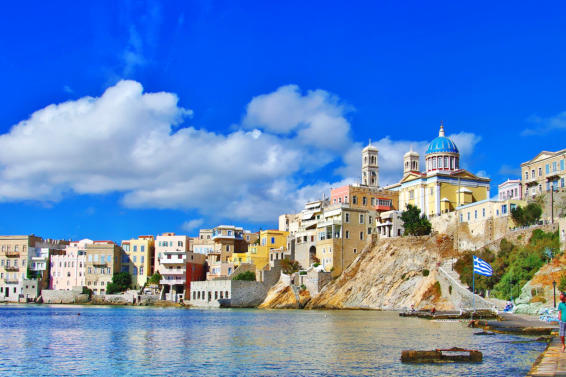The
capital
of
Syros
as
well
as
of
the
insular
complex
of
the
Cyclades
exudes
an
aura
of
neoclassical
romance
harmoniously
combining
elements
from
ancient Greece and Western Europe.
Visitors
are
welcome
to
follow
the
narrow
streets
through
the
picturesque
neighborhoods,
discover
images
and
experiences
of
a
bygone
era
and
encounter
monuments
along
with
neoclassical
buildings
from
the
imperious
history.
From
the
impressive
Town
Hall
in
Miaouli
square,
inspired
by
Ernest
Ziller
and
the
palaces
of
Troy,
the
Apollon
Theater
which
is
a
miniature
of
Scala
di
Milano,
the
mansions
in
the
charming
area
of
Vaporia,
the
municipal
library
and
the
remarkable
museums
of
the
island
to
the
Temple
of
the
resurrection
and
other
beautiful
Orthodox
and
Catholic
churches,
the
town
of
Ermoupolis
constitutes
much
more
than
a
beautiful
island
capital,
it
constitutes
an
open-
air
museum
worth
exploring
from
side
to
side.
It
is
a
cosmopolitan
capital
with
its own special character, a vibrant city buzzing with life throughout the year.
Ermoupolis
has
an
excellent
tourist
infrastructure
and
offers
a
wide
variety
of
facilities
for
accommodation,
dining,
entertainment
and
relaxation
with
a
breadth
of
accommodation
options,
cafes,
restaurants
and
bars
as
well
as
plenty of sports facilities and cultural venues.
The
Syros
Culture
festival
constitutes
one
of
the
island’s
main
cultural
institutions
and
a
benchmark
for
its
guests.
It
is
a
festival
held
each
year
during
the
summer
giving
an
even
more
impressive
cultural
extension
to
the
island.
Ermoupolis
is
the
main
port
of
the
island
connected
daily
with
the
ports
of
Piraeus,
Rafina,
the
Cyclades
and
the
North
Aegean
Sea.
The
island’s
airport
is
situated
at
a
distance of 3 kilometers and offers direct flights to Athens.
SYROS, THE ISLAND OF 4 SEASONS.
Syros
dominates
the
heart
of
the
Aegean
with
the
dynamic
character
and
the
cosmopolitan
grace
of
a
queen.
As
a
dominant
force
centered
in
Ermoupoli,
the
capital
of
the
island
and
of
the
Cyclades
continues
to
preserve
and
enhance
the
glamour
of
a
bygone
era.
Sharing
a
story
that
unfolds
through
the
winding
alleys,
the
traditional
villages
that
brilliantly
orchestrate
the
medieval
with
the
Cycladic
architecture,
the
Orthodox
and
Catholic
churches,
the
stunningly
beautiful
beaches,
the
azure
sea
and
the
magical
natural scenery.
Unforgettable holidays in Syros.
Just
83
nautical
miles
from
the
port
of
Piraeus
and
62
miles
from
the
port
of
Rafina,
Syros
Island
is
one
of
the
most
favorite
holiday
destinations
in
the
Cyclades,
ideal
for
travelers
with
refined
taste.
Before
you
travel
to
this
unique
island
in
the
Aegean
Sea
make
sure
to
acquire
a
travel
Map
of
Syros,
check
out
the
latest
news,
the
local
updates
and
the
most
important
tourist
news
of
Syros
so,
as
to
collect
all
information
needed
about
the
attractions,
the
historical
sites,
the
beaches,
the
best
hotels
to
stay
at while on the island and pick your favorite sites for the most enjoyable holidays in Syros.
THE ISLAND.
An island, a city, a live museum
Explore
the
live
museum
of
Syros,
the
Orthodox
and
Orthodox
Cathedrals
churches,
the
medieval
buildings
and
the
monuments
that
will
lure
you
to
a
different period in time.
The
central
location
of
the
island
made
Syros
one
of
the
most
important
ports
in
the
Eastern
Mediterranean
during
the
19th
century,
soon
turning
it
into
the
commercial,
administrative
and
cultural
center
of
the
Cyclades
island
complex.
Ermoupolis
still
resembles
an
open-air
museum,
a
live
monument
of
neoclassical
architecture
with
relics
and
cultural
treasures
worth
discovering.
From
the
medieval
city
of
Ano
Syros,
the
ancient
monuments
of
the
Early
Cycladic
period
in
Kastri,
the
municipality
of
Syros-Ermoupolis,
the
Apollon
Theater
resembling
Scala
di
Milano,
the
Orthodox
and
Catholic
coexistence
as
well
as
the
various
influences
from
Asia
Minor
and
all
the
way
to
the
machine
center
in
Neorion
operating
since
1861, Syros is a unique place of everlasting historical tradition and culture.
Syros- holidays all year round
The
island’s
privileged
location
along
with
its
advanced
tourist
infrastructure
and
special
character
make
it
an
ideal
destination
for
authentic
and
alternative
holidays
in
the
Cyclades.
Syros
is
considered
a
favorable
pole
of
attraction
throughout
the
year
as
each
season
dresses
the
already
breathtaking
scenery
with
its
own
colors
and
aromas,
with
its
own
beauties
and
contrasts
always
offering
a
special and unforgettable experience for all visitors.
HISTORY.
Today
Syros
with
its
capital
Ermoupolis
is
an
island
gem
with
a
well-developed
economy,
tourism
and
agricultural
production
while
the
operation
of
the
shipyard,
of
public
services,
of
the
Department
of
product
and
systems
design
engineering
at
the
University
of the Aegean as well, contribute to the long-term development of the island.
Prehistoric
findings
in
the
areas
of
Halandriani
and
Kastri
prove
that
Syros
has
been
inhabited
since
the
3rd
millennium
BC
and
also
had
a
great
commercial
activity
while
various
evidence
for
the
existence
of
metallurgy
plans
bears
witness
to
the
island’s
relationship
with
Asia
Minor.
During
the
2nd
millennium
Syros
is
found
under
the
rule
of
the
Phoenicians,
of
Minoan
Crete
and
the
Mycenae
while
in
the
1st
Millennium
the
island
passes
to
the
hands
of
the
Ionians.
From
the
7th
to
the
3rd
century
B.C.
there
are
traces
of settlements and rural areas in different parts of the island.
In
the
classical
and
Hellenistic
period
Syros
joins
the
Athenian
Alliance
with
its
own
currency
and
administration
while
during
the
Hellenistic
period
findings
of
temples
are
brought
to
life
like
the
one
of
the
philosopher
of
antiquity
Pherecydes
between
Richopos
and
Platy
Vouni
in
Ano
Syros.
The
cosmologist
Pherecydes
was
born
and
died
on
the
island
in
the
6th
century
BC.
He
was
a
teacher
who
taught
in
Samos
some
of
the
greatest
scientists
of
ancient
times
such
as
Pythagoras,
and
is
said
that
he
spent
most
of
his
life
inside
a
cave.
The
cave
survives
to
the
day
in
a
magical
landscape
where
earth
and
sky
become
one,
where
the
view
to
the
sea
can
only
be
described
as
miraculous.
Apart
from
being
a
great
philosopher
Pherecydes
was
also
the
inventor
of
the
first
solar
clock,
also
known
as
the
Sunflower
of
Pherecydes.
The
sunflower
looks
like
a
sump
or
well
that
could
be
used
in
antiquity
for
the
irrigation
of
water.
In
fact
it
is
an
ancient
and
expensive
solar
observatory
that
marks
the
time
and
the
4
seasons
of
Syros
depending
on
the
motion
of
the
Sun.
This
prehistoric
Sunflower
is
located
in
the
village
of
San
Michali.
The
copper
coins
found
on
the
island
from
the
Roman
times
and
the
issuance
of
silver
coins
in
the
2nd
century
BC
show
commercial
development
while
the
invading
pirates
during
the
Byzantine
period
cause
the
abandonment
of
the
island.
Soon
Syros
becomes
part
of
the
Theme
of
the
Aegean
Sea
and
the
first
Catholic
settlement
of
Ano
Syros
is
created
under
the
rule
of
the
Venetians.
In
the
Ottoman
period
Syros
passes
into
a
new
era
characterized
by
the
reduction
of
taxes,
the
freedom
of
religion
and
the
establishment
of
both
the
Capuchin
Monks
and
the
Jesuits
who
leave their individual mark on the island.
In
1728
the
island
suffers
from
the
plague,
but
slowly
and
gradually
until
the
19th
century
it
reaches
an
economic
growth
and
moves
towards
the
development
of
a
self-government
and
a
public
assembly.
The
island’s
population
doubles,
reaching
4000
inhabitants
and
begins
to
show
a great improvement in the fields of trade and shipping.
During
the
Greek
Revolution
of
1821,
the
refugees
from
Smyrni
and
Aivali
as
well
as
from
the
nearby
islands
find
shelter
on
the
island
where
they
built
the
first
houses
as
well
as
the
first
Orthodox
temple
and
slowly
transform
Ano
Syros
into
a
city-jewel,
a
city
characterized
by
its
vibrant
spirit
and
its
magnificent
architecture,
a
city
that
gave
a
boost
to
businesses
that
slowly
and
steadily
began
to
grow.
With
22,000
inhabitants
in
1889,
the
town
of
Ermoupolis
becomes
a
superpower
engaged
in
manufacturing,
shipping,
building
activities,
tannage
while
promoting
intellectual
freedom
with
the
establishment
of
schools,
clubs
and
theaters
such as the Apollo theater that quickly began to blossom.
The
20th
century,
however,
starts
with
unpleasant
omens
for
the
island,
the
power
acquired
by
Athens
and
Piraeus,
the
opening
of
the
Corinth
Canal,
the
development
of
steam navigation and the occupation by the Germans in 1941 slowly bring complete destruction.
After
the
occupation,
the
limited
agricultural
production
carries
on
while
factories
begin
to
close
down
the
one
after
the
other
and
the
population
of
the
island
diminishes
day by day.
But slowly and gradually Syros is reborn from its ashes, it is once again molded and transformed as culture is a concept deeply rooted in its grounds.
The
island’s
spiritual
and
artistic
tradition
begins
to
attract
tourists
of
high
cultural
and
social
status.
The
exceptional
mansions
as
well
as
the
unique
architecture
of
public
buildings in Ermoupoli give the feeling of an open-air museum that slowly begins to be acknowledged by the continuous visitors.
TRADITION
The
morals,
customs
and
traditions
of
the
island
are
revived
during
religious
holidays
and
local
events
inspired
by
the
roots
of
the
past.
The
traces
of
the
local
cultures
are
awaken
through
various
customs
such
as
Fotaerides,
Klidonas,
Koulouma,
Choirosfagia,
the
Carnival
of
Syros
and
the
unique
Easter celebrations.
Fotarides
On
the
15th
of
August
in
the
village
of
Kini
all
families
decorate
the
exterior
of
their
homes
with
fires
that
are
lit
in
small
tin
cans
while
the
kids
are
responsible
for
the
decoration
of
the
beach
and
the
surrounding
terraces
in
the same way.
Klidonas
According
to
the
custom
of
Klidonas
taking
place
on
June
24th,
all
the
inhabitants
of
Chroussa
gather
at
an
elementary
school
of
the
village,
light
fires and burn the wreaths that have been created on May 1st.
Koulouma
Celebrated
in
several
parts
of
the
country,
the
Koulouma
taking
place
at
Galissa
are
dedicated
to
the
celebration
of
Clean
Monday
during
which
attendees
participate
in
kite-flying
contests
and
continue
the
festivities
with
traditional dancing, singing and local dishes.
Choirosfagia
A
tradition
that
has
been
preserved
for
many
years
regarding
the
rearing
of
pigs,
the
chopping
and
assortment
of
meat
for
the
celebration
of
Christmas.
Based
on
the
tradition
every
single
piece
from
the
pig
must
be
preserved
in
the
form
of
sausages,
louza,
glyna
and
pyxti
so
as
to
be
used
for
the
cold
winter
nights.
The
Choirosfagia
tradition is of course accompanied by dancing, singing and local dishes.
The Carnival of Syros
The
two-day
Carnival
of
Syros
is
one
of
the
most
famous
carnivals
in
Greece.
Every
year
a
big
parade
with
floats
is
organized
both
in
Ano
Syros
and
Ermoupoli
and
it
is
accompanied
by
music,
dancing
and
traditional delicacies.
Easter
The
devout
atmosphere
combined
with
the
Orthodox
and
Catholic
coexistence
make
Easter
on
the
island
a
truly
unrivaled
experience
with
the
procession
of
the
epitaph
from
Orthodox
followers
holding
spars,
dice,
sponges
and
tunics
symbolizing
the
sufferings
of
Christ
and
the
procession
of
the
statue
of
Jesus
after
the
Resurrection
by the Catholics.
ENTERTAINMENT IN SYROS.
The
cosmopolitan
island
of
Syros
is
a
picturesque
island
offering
various
choices
of
entertainment
for
all
tastes
and
preferences.
From
the
atmospheric
cafés
and
bars
in
the
capital,
Ermoupolis,
to
the
beaches
of
Galissas,
and
Poseidonia
all
the
way
to
Ano
Syros
with
its
romantic
pool
bars
overlooking
the
endless
Aegean
Sea,
Syros
is
an
island
with
an
effervescent
character.
With
the
clubs
in
the
heart
of
the
city
and
the
timeless
nightlife,
Syros
promises
to
elevate
the
mood
of
all
visitors.
For
every
traveller
wondering
what
to
do
while
on
the
island
the
answer
lies
in
the
island’s
entertainment
guide
providing
detailed
information
about
the
nightlife
in
Syros,
Syros’s
attractions
and
also
the
several
other
alternative activities.
Along
the
picturesque
streets
of
Ermoupoli,
travellers
are
invited
to
relax
in
one
of
the
café’s
down
the
port,
overlooking
the
magnificent
sea,
stroll
around
in
the
picturesque
neighbourhoods
with
their
neoclassical
mansions
and
enjoy
a
refreshing
cocktail
in
a
bar
of
their
choice
while
the
sky
overflows
with
the
colours
of
the
sunset.
As
the
night
begins
to
fall
on
the
cosmopolitan
capital,
the
flickering
city
lights
add
an
extra
glow to the island’s effervescent night time scene.
